Related Research Articles

Gabbro is a phaneritic (coarse-grained), mafic intrusive igneous rock formed from the slow cooling of magnesium-rich and iron-rich magma into a holocrystalline mass deep beneath the Earth's surface. Slow-cooling, coarse-grained gabbro is chemically equivalent to rapid-cooling, fine-grained basalt. Much of the Earth's oceanic crust is made of gabbro, formed at mid-ocean ridges. Gabbro is also found as plutons associated with continental volcanism. Due to its variant nature, the term gabbro may be applied loosely to a wide range of intrusive rocks, many of which are merely "gabbroic". By rough analogy, gabbro is to basalt as granite is to rhyolite.

A pegmatite is an igneous rock showing a very coarse texture, with large interlocking crystals usually greater in size than 1 cm (0.4 in) and sometimes greater than 1 meter (3 ft). Most pegmatites are composed of quartz, feldspar, and mica, having a similar silicic composition to granite. However, rarer intermediate composition and mafic pegmatites are known.
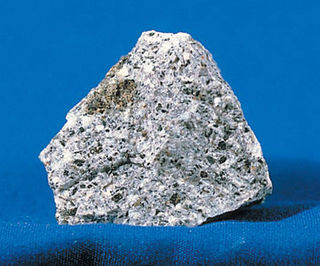
Syenite is a coarse-grained intrusive igneous rock with a general composition similar to that of granite, but deficient in quartz, which, if present at all, occurs in relatively small concentrations. It is considered a granitoid. Some syenites contain larger proportions of mafic components and smaller amounts of felsic material than most granites; those are classed as being of intermediate composition.

Trachyte is an extrusive igneous rock composed mostly of alkali feldspar. It is usually light-colored and aphanitic (fine-grained), with minor amounts of mafic minerals, and is formed by the rapid cooling of lava enriched with silica and alkali metals. It is the volcanic equivalent of syenite.

Phonolite is an uncommon shallow intrusive or extrusive rock, of intermediate chemical composition between felsic and mafic, with texture ranging from aphanitic (fine-grained) to porphyritic (mixed fine- and coarse-grained). Phonolite is a variation of the igneous rock trachyte that contains nepheline or leucite rather than quartz. It has an unusually high (12% or more) Na2O + K2O content, defining its position in the TAS classification of igneous rocks. Its coarse grained (phaneritic) intrusive equivalent is nepheline syenite. Phonolite is typically fine grained and compact. The name phonolite comes from the Ancient Greek meaning "sounding stone" due to the metallic sound it produces if an unfractured plate is hit; hence, the English name clinkstone is given as a synonym.
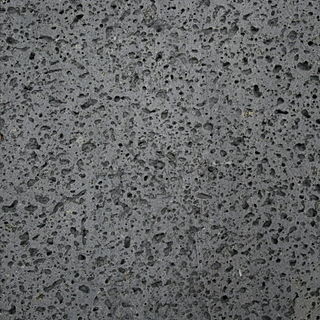
Tephrite is an igneous, volcanic (extrusive) rock, with aphanitic to porphyritic texture. Mineral content is usually abundant feldspathoids, plagioclase, and lesser alkali feldspar. Pyroxenes (clinopyroxenes) are common accessory minerals. Quartz and olivine are absent. Occurrences include leucite nepheline tephrite from Hamberg bei Neckarelz near Heidelberg, Germany, phonolite-tephrite at Monte Vulture, Basilicata, Italy and basanite–tephrite intrusions in Namibia.

Basanite is an igneous, volcanic (extrusive) rock with aphanitic to porphyritic texture. It is composed mostly of feldspathoids, pyroxenes, olivine, and plagioclase and forms from magma low in silica and enriched in alkali metal oxides that solidifies rapidly close to the Earth's surface.
The feldspathoids are a group of tectosilicate minerals which resemble feldspars but have a different structure and much lower silica content. They occur in rare and unusual types of igneous rocks, and are usually not found in rocks containing primary quartz. A notable exception where feldspathoids and quartz-bearing rocks are found together is the Red Hill Syenite.

Nepheline syenite is a holocrystalline plutonic rock that consists largely of nepheline and alkali feldspar. The rocks are mostly pale colored, grey or pink, and in general appearance they are not unlike granites, but dark green varieties are also known. Phonolite is the fine-grained extrusive equivalent.
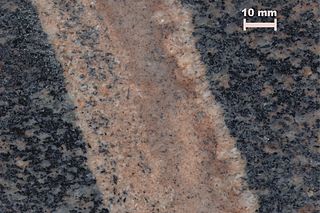
Aplite is an intrusive igneous rock in which the mineral composition is the same as granite, but in which the grains are much finer, under 1 mm across. Quartz and feldspar are the dominant minerals. The term aplite or aplitic is often used as a textural term to describe veins of quartz and feldspar with a fine to medium-grain "sugary" texture. Aplites are usually very fine-grained, white, grey or pinkish, and their constituents are visible only with the help of a magnifying lens. Dykes and veins of aplite are commonly observed traversing granitic bodies; they occur also, though less frequently, in syenites, diorites, quartz diabases, and gabbros.
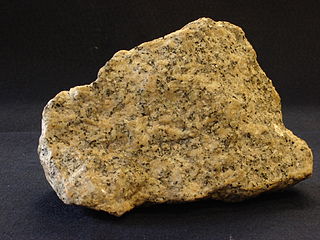
A granitoid is a generic term for a diverse category of coarse-grained igneous rocks that consist predominantly of quartz, plagioclase, and alkali feldspar. Granitoids range from plagioclase-rich tonalites to alkali-rich syenites and from quartz-poor monzonites to quartz-rich quartzolites. As only two of the three defining mineral groups need to be present for the rock to be called a granitoid, foid-bearing rocks, which predominantly contain feldspars but no quartz, are also granitoids. The terms granite and granitic rock are often used interchangeably for granitoids; however, granite is just one particular type of granitoid.

Pyroxenite is an ultramafic igneous rock consisting essentially of minerals of the pyroxene group, such as augite, diopside, hypersthene, bronzite or enstatite. Pyroxenites are classified into clinopyroxenites, orthopyroxenites, and the websterites which contain both types of pyroxenes. Closely allied to this group are the hornblendites, consisting essentially of hornblende and other amphiboles.

Lamprophyres are uncommon, small-volume ultrapotassic igneous rocks primarily occurring as dikes, lopoliths, laccoliths, stocks, and small intrusions. They are alkaline silica-undersaturated mafic or ultramafic rocks with high magnesium oxide, >3% potassium oxide, high sodium oxide, and high nickel and chromium.

Lamproite is an ultrapotassic mantle-derived volcanic or subvolcanic rock. It has low CaO, Al2O3, Na2O, high K2O/Al2O3, a relatively high MgO content and extreme enrichment in incompatible elements.

Aegirine is a member of the clinopyroxene group of inosilicate minerals. It is the sodium endmember of the aegirine–augite series. It has the chemical formula NaFeSi2O6, in which the iron is present as the ion Fe3+. In the aegirine–augite series, the sodium is variably replaced by calcium with iron(II) and magnesium replacing the iron(III) to balance the charge. Aluminum also substitutes for the iron(III). Acmite is a fibrous green-colored variety.

Litchfieldite is a rare igneous rock. It is a coarse-grained, foliated variety of nepheline syenite, sometimes called nepheline syenite gneiss or gneissic nepeheline syenite. Litchfieldite is composed of two varieties of feldspar, with nepheline, sodalite, cancrinite and calcite. The mafic minerals, when present, are magnetite and an iron-rich variety of biotite (lepidomelane).
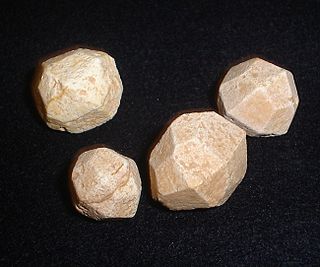
Leucitite or leucite rock is an igneous rock containing leucite. It is scarce, many countries such as England being entirely without them. However, they are of wide distribution, occurring in every quarter of the globe. Taken collectively, they exhibit a considerable variety of types and are of great interest petrographically. For the presence of this mineral it is necessary that the silica percentage of the rock should be low, since leucite is incompatible with free quartz and reacts with it to form potassium feldspar. Because it weathers rapidly, leucite is most common in lavas of recent and Tertiary age, which have a fair amount of potassium, or at any rate have potassium equal to or greater than sodium; if sodium is abundant nepheline occurs rather than leucite.

Shonkinite is an intrusive igneous rock found in few places in the world. It is unique in having low silica, feldspathoid minerals, and large blocky crystals of black augite. It makes up much of the hard dark grey rock comprising certain mountains and buttes in Montana that are remnants of laccoliths and stocks, such as the Highwood mountains.

The Red Hill Syenite is a layered igneous rock complex in central New Hampshire, about 20 mi (32 km) east of Plymouth. The Red Hill Syenite is part of the White Mountain magma series, which underlays the White Mountains of New Hampshire. Red Hill is roughly oval-shaped, covers just under 7.7 square miles (20 km2), and has a summit elevation of 2,028 feet (618 m).
References
- ↑ Parsons, I., Loch Borralan Intrusion, Volume 17: Caledonian Igneous Rocks of Great Britain Chapter 7: Late Ordovician to mid-Silurian alkaline intrusions of the North-west Highlands of Scotland, Geological Conservation Review, 2007,
- ↑ Searle, M.P., et al., Relationships Between the Loch Ailsh and Boralan Alkaline Intrusions and Thrusting in the Moine Thrust Zone, Southern Assynt Culmination, Northwest Scotland, pp 383-404 in Continental Tectonics and Mountain Building: The Legacy of Peach and Horne, Geological Society Of London, 2010, ISBN 978-1862393004
- ↑ Loch Borralan: Alkaline igneous intrusions
- ↑ One or more of the preceding sentences incorporates text from a publication now in the public domain : Flett, John Smith (1911). "Borolanite". In Chisholm, Hugh (ed.). Encyclopædia Britannica . Vol. 4 (11th ed.). Cambridge University Press. p. 267.